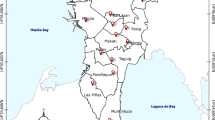Summary
For the identification of air pollution sources, about 500 airborne particulate matter (PM2.5and PM10) samples were collected by using a Gent air sampler and a polycarbonate filter in an urban region in the middle of Korea from 2000 to 2003. The concentrations of 25 elements in the samples were measured by using instrumental neutron activation analysis (INAA). Receptor modeling was performed on the air monitoring data by using the positive matrix factorization (PMF2) method. According to this analysis, the existence of 6 to 10PMF factors, such as metal-alloy, oil combustion, diesel exhaust, coal combustion, gasoline exhaust, incinerator, Cu-smelter, biomass burning, sea-salt, and soil dust were identified.
Similar content being viewed by others
Author information
Authors and Affiliations
Rights and permissions
About this article
Cite this article
Chung, YS., Kim, SH., Moon, JH. et al. Source identification and long-term monitoring of airborne particulate matter (PM2.5/PM10) in an urban region of Korea. J Radioanal Nucl Chem 267, 35–48 (2005). https://doi.org/10.1007/s10967-006-0006-z
Issue Date:
DOI: https://doi.org/10.1007/s10967-006-0006-z




